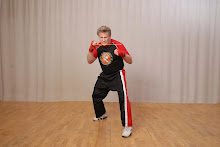Bruce Lee and Cus D’Amato Said Same Thing
Cus D’Amato was hailed by Ring Magazine as one of the top five trainers in the past 75 years of boxing. Although the champion, Rocky Graziano, slipped out of D’Amato’s hands as his trainer, Cus developed three other notable world champions, Floyd Patterson, José Torres, and Mike Tyson.
Before Bert Randolph Sugar took control of Ring Magazine in 1979, the magazine’s staff had sent Mr. D’Amato to meet me in New York City in an attempt to get me to come to the Catskills in New York State to train with him in hopes of some day fighting Mohammad Ali. Although at that time (in 1971) I had been knocking out all my kickboxing opponents in less than two rounds, my heart was into acting, not fighting. I was already a champion in two separate fighting sports; however, Cus was very disappointed in my lack of interest to pursue becoming a pro boxer.
I felt that Cus and Bruce Lee shared some of the same ideas on tactics of ring strategy. Take time to view this clip and I will highlight a few concepts that both Cus and Bruce talked about with me at length. I have marked the time intervals on the clip at the exact place my comments are relevant.
The main point both Bruce and Cus shared about fighting was accepting the practice of developing head rhythm for defense of one’s cranial cavity, and body rhythm for defense of ones body---not the use of ones hand (blocking, trapping, cuffing, etc) for defense. This premise is the “opposite” of what the majority of martial arts styles advocates and teach. They each believed in what is called an aggressive defensive---if you have the time to block or trap, then you have time to hit. [In other words, one uses head rhythm to protect the head, body rhythm to protect the body, and foot rhythm (and leg checks) to protect the legs.]
Clip time: (1:50 min) D’Amato uses defensive timing to work in behind Ali’s punches. Ali had a tendency to pause at the end of his combinations---thus leaving his “back door” open for a counter. This is where Ali often got hit during his fights; he entered the pocket but didn’t disengage quickly enough or he exited the same route in which he entered. This is a weakness of most martial arts fighting styles.
Clip time: (4:32) Ali leaves too much hang time on the end of his right punch, often his straight right. Notice Ali is leaning too much---overextending his right hand---which leaves him off balance. This make him vulnerable for a perfectly timed counter and it causes him to be unable to follow up with a left hook or left forty-five punch. Cus told me that this was the key to how he could teach me to beat Ali. He would have me draw Ali’s straight right; I would slip it outside, and come underneath with a shovel hook to the liver.
I’ve worked that move for decades and it has become my favorite “dirty dozen” shot. Anyone can drop a fighter with a cranial shot; few fighters have ever developed an accurate knock-out body punch. Many martial artists have acquired the same bad habit as Ali---they lean too much when they punch and end up with their shoulder forward of their feet. Rule: Always keep your feet under your punches.
Clip time: (4:36) Ali catches hooks while caught on the ropes. This was one of his bad habits and the same is true of many combatants. One must learn to keep his back always pointed towards the center of the ring. If your opponent tries to cut the ring off (called squeezing) avoid the habit of always moving straight backwards.
In the end, a master fighter knows how to execute the three attributes of an effective strategy: 1) confuse, 2) deceive, and 3) then exploit your opponent. The key skill necessary to pull off this kind of control is mobility. Keep in mind that Ali, Dempsey, and Tyson all three had a three-year plus layoff during their careers for various reasons. When each of them eventually returned to the ring for their first return bout, neither of them still had their strong legs and they paid the price.
“The hero and the coward both feel the same thing, but the hero uses his fear, projects it onto his opponent, while the coward runs. It's the same thing, fear, but it's what you do with it that matters.” Cus D’Amato
Subscribe to:
Post Comments (Atom)

Excellent article that reveals nuances in fight strategy, excecution, and history. Great stuff.
ReplyDelete